The following piece is part of The Aerogram’s collaboration with the South Asian American Digital Archive (SAADA), which documents and shares the history of South Asian Americans.
***

This Mother’s Day is a great opportunity to turn the spotlight on one of the first South Asian women (and moms) to immigrate to the United States: Kala Bagai Chandra, who figuratively was “Mother India” to many in the nascent Indian-immigrant community of Southern California up until her death in 1983.
Born in 1893 in Amritsar, she was married at age 11 to Vaishno Das Bagai, who was 12 at the time. In 1915, she, her husband, and their three sons sailed into San Francisco. (Vaishno, an ardent supporter of India’s independence from Britain, believed that in America, with all its freedoms, he could do more for the independence cause than in India, where he faced British oppression.)
A news article from the time, available through the South Asian American Digital Archive, said Kala was the first Hindu woman to enter the city in 10 years. She was a 22-year-old mom of three who didn’t speak English and was far from home at a time when Skype and email didn’t exist.


Vaishno had a substantial inheritance from his family and managed to open a general store and start an import-export business. He even became a U.S. citizen. Unfortunately, the ruling in the 1923 Supreme Court case United States v. Bhagat Singh Thind made Indians ineligible for U.S. citizenship due to the judges’ decision that Indians aren’t white. Vaishno was denaturalized, and loss of citizenship meant he had to liquidate his store. After being unable to obtain a U.S. passport to travel back to India (and certainly not wanting a British passport), he took his life in 1928.
Kala became a single mom in San Francisco.
Life took another twist, though, in 1934: Kala married Mahesh Chandra, a family friend of her and Vaishno. Kala made it very clear that there was no romantic component to the marriage, according to Rani Bagai, Kala’s granddaughter, who gave an oral-history interview in 2013. Rani said her grandmother would say something along the lines of “‘There wasn’t, you know, any of…that love business.’” Rather, said Rani, the marriage was a partnership: Kala took care of Mahesh and cooked his meals, while she had a man around the house to provide a sense of safety and financial security. The marriage was remarkable in that a widow remarrying was very much against Indian cultural norms of the time.
Kala Bagai Chandra and her husband moved to Southern California, and Kala became a U.S. citizen after the passage of the Luce-Celler Act of 1946, which allowed Indians living in the United States (about 2,500 to 3,000 at the time) to naturalize.
As a mom, grandma, and wife, Kala cooked family dinners featuring large quantities of food. Even when your stomach was absolutely stuffed, she would urge you to eat more and more, saying, “‘But you didn’t eat anything. Have more,’” recalled Rani. During dinners, Kala would often be at the stove, churning out hot, fresh rotis. She was vegetarian, but she could make tasty chicken curry without having to taste-test it.
A diary that Kala kept in 1955 reveals not intimate personal thoughts, but a logbook of the mundane details of daily life. (By then Kala had learned English.) On Jan. 1, she watched the Rose Parade on TV and saw the movie Sabrina. On Feb. 24, she bought a weighing scale for $8.75 ($81.48 in 2018 dollars); she wrote that she weighed 134 pounds with her clothes on (she reported her height as 4’10” on her passport application years later). A follower of the stock market, she regularly wrote down the high, low, and closing prices of a list of stocks. “BS” (Bethlehem Steel) was at the top of her list. On Feb. 18, she wrote that it “made a new high,” and on March 4 she wrote “sold my Bethlehem Steel” at $129.60 (after having bought it at $51.50).
After the Immigration and Nationality Act of 1965, more Indians began immigrating to the United States, and many in the Los Angeles area found comfort in the Indian community that Kala had helped build. She was known as “Mother India,” while her home was essentially a “little India,” according to a 1983 obituary. Her family and friends lovingly called her Jhaiji — Punjabi for “grandmother.”
After Kala passed away in 1983 at age 90, a tribute was held in her honor. The program booklet said, “Symbolically, she became everyone’s Jhaiji,” and it described her as one of “the first pioneer Indian ladies to migrate to the United States.”
And Kala Bagai Chandra truly was a pioneer, the first in a long line of roti-making Indian-immigrant moms.
***
Preeti Aroon (@pjaroonfp) is a Washington, D.C.–based copy editor at National Geographic and was formerly copy chief at Foreign Policy.













1 thought on “Meet ‘Mother India’: One of the First Indian Women to Immigrate to America”
Comments are closed.